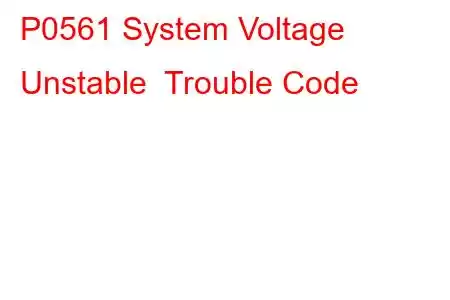P0561 System Voltage Unstable
OBD-II Trouble Code Technical Description
System Voltage Unstable
What does that mean?
This generic powertrain/engine diagnostic trouble code typically applies to all 1996-newer vehicles, including but not limited to Kia, Hyundai, Jeep, Mercedes, Dodge, Ford and GM vehicles.
The PCM controls the charging system to a certain extent on these vehicles. The PCM can control the charging system by controlling a power or a ground circuit to the voltage regulator inside the alternator.
The Powertrain Control Module (PCM) monitors the ignition feed circuit to determine if the charging system is working. If the voltage is too high or too low, a fault code will be set. If the voltage is not present when it should be, a fault code will be set. This is strictly an electrical issue.
Troubleshooting steps may vary depending upon manufacturer, type of charging system control and wire colors.
Symptoms
Symptoms of a P0561 engine code may include:
Malfunction Indicator Light On Red battery light On Transmission may not shift Engine may not start or if it does start, may stall out and die Lower fuel economyCauses
Potential causes for this code to set are:
High resistance in the cable between the alternator and battery - possible High resistance/open circuit between the alternator and the control module - possible Alternator faulty – most common Failed PCM - unlikelyDiagnostic and Repair Procedures
A good starting point is always to check for technical service bulletins (TSB) for your particular vehicle. Your issue may be a known issue with a known fix put out by the manufacturer and can save you time and money during diagnosis.
The most common cause for this code is low battery voltage/a battery that was disconnected/charging system malfunction (faulty alternator). While we are on the subject, let’s not forget to check the most neglected part of the charging system, the alternator belt!
First, check the charging system. Start the vehicle. Turn the headlights on and blower fan to High speed to load the electrical system. Using a Digital Volt Ohm Meter (DVOM), check voltage at the battery. It should be between 13.2 volts and 14.7 volts. If the voltage is well below 12 volts or above 15.5 volts, diagnose the charging system, with the main emphasis being on the alternator. If unsure, have the battery, starting and charging system tested at a local parts store / auto repair shop. Most will perform this service for a small charge, if not for free, and will usually give you a printout of the test results.
If the voltage was correct, and you have a scan tool, clear the diagnostic trouble codes from memory, and see if this code returns. If it does not, more than likely this code is either intermittent or is a history/memory code and no further diagnosis is required.
If the P0561 code does return, locate the PCM on your particular vehicle. Once located, visually inspect the connectors and wiring. Look for scraping, rubbing, bare wires, burn spots or melted plastic. Pull the connectors apart and carefully inspect the terminals (the metal parts) inside the connectors. See if they look burned or have a green tint indicating corrosion. Use electrical contact cleaner and a plastic bristle brush if cleaning of the terminals is needed. Let dry and apply electrical grease where the terminals contact.
Next, clear the diagnostic trouble codes from memory with the scan tool, and see if this code returns. If it does not, then the connections were most likely your problem.
If the P0561 code does return, we will need to check the voltages to the PCM. First, disconnect the negative battery cable at the battery. Next, disconnect the harness going to the PCM. Reconnect the battery cable. Turn the ignition switch on. With a DVOM, test the PCM ignition feed circu
Read: 42


